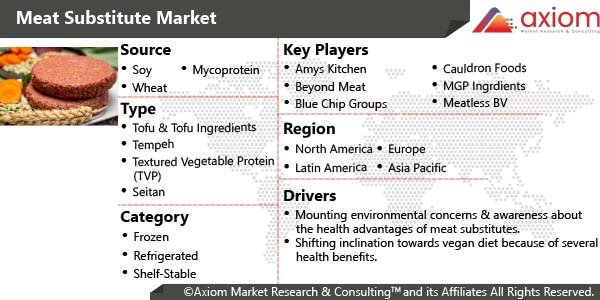Meat substitutes are meatless food that has approximately the same taste, appearance, and texture of a related food made from meat, poultry, fish or shellfish. The main source used in formulation of meat substitutes are plant proteins such as glutens and globulins. The most commonly used ingredients are soy proteins, cereal proteins, vegetables, mycoproteins, pulses and nuts. Other components such as egg albumin, carbohydrates and gums are frequently used in development of meat substitutes. Meat substitutes contain high amount of protein and calcium; thus, intake of these substitutes is largely observed among sportspersons and young generation. Ongoing trends such as vegan and consuming plant protein, has shown extraordinary results in reduction of cholesterol, preventing menopausal complications and various other diseases. The health benefits of this cholesterol-free protein, with meat-like texture, is the main factor promoting the growth of meat substitute products. Meat substitutes fill the diet gaps and offer various health benefits by providing essential elements that nourish human body. Across the globe, a large percentage of population is preferring vegetarian food that has impelled the demand for meat substitutes.
Meat Substitute Market Outlook
The meat substitute market has gained remarkable growth due to health benefits of meat substitutes and increased preference for vegetarian foods. Also, increase in incidence of health disorders and fitness awareness among consumers are expected to drive the meat substitute market growth. Furthermore, companies are innovating and developing product lines for meat substitutes due to increasing adoption level of meat substitutes by consumers. However, lack of good taste in comparison to natural meat products is hindering the global meat substitute market. However, rising organized retail sector for meat substitutes is expected to provide strong market growth opportunity in the future.
Meat Substitute Market Segmental Overview
The meat substitute market is segmented by type, source, category, distribution channel and geography.
Meat Substitute Market by Type
Based on type, the meat substitute market is segmented into tofu & tofu ingredients, tempeh, textured vegetable, protein (TVP), seitan, Quorn and other meat substitutes (risofu, valess, lupine, and pea protein). In 2018, the tofu segment recorded largest portion of the meat substitute market. Tofu is a versatile soy-based meat substitute that is high in protein and may contain added nutrients such as calcium and vitamin B12 that are important for a vegan diet. However, among vegetarian consumers this segment has become popular meat substitute. Moreover, Seitan which contains higher amounts of sodium and protein than tempeh and tofu is expected to arise as the fastest-growing product segment in the global market.
Meat Substitute Market by Source
Based on source, the meat substitute market is segmented into soy-based meat substitute, wheat-based meat substitute and mycoprotein-based meat substitute. Soy is the best known meat substitute in market. Soy based products are rich in vitamins, fibers, amino acids, cholesterol-free and extremely rich in protein. Owing to these properties the soy-based meat substitute dominated the market in 2018. Soy-based products are more prevalent toward the western region while wheat-based meat substitutes are more dominant in the Asia Pacific region.
Meat Substitute Market by Category
On the basis of category, the meat substitute market is segmented into refrigerated and frozen meat substitutes. Change in consumers buying patterns, moving from small grocery shops to hyper markets, the frozen meat segment recorded the largest share in the global market followed by the refrigerated meat segment. The developing counties such as India, China and Brazil are the emerging market for frozen meat segment.
Meat Substitute Market by Distribution Channel
Based on distribution channel, the meat substitute market is segmented into direct sales and indirect sales. The indirect sales further segmented into modern groceries, discount stores, convenience stores, food & drink specialty stores, traditional grocery stores and online retail. The indirect sales segment has dominate the meat substitute market in 2018, owing to increase in demand from modern groceries such as supermarkets, hypermarkets and online retails.
Meat Substitute Market by Geography
Based on geography, the meat substitute market is segmented into North America, Latin America, Europe, Asia Pacific and Middle East & Africa. Europe is accounted the highest portion in the meat substitute market in 2018. Whereas, the Asia pacific is projected to record the highest growth over the forecast period 2020 to 2025. Rise in disposable income of consumers and Increase in adoption of western lifestyle are majorly driving the meat substitute market growth.
Meat Substitute Market Key Players
Key players operating in the meat substitute market include Amys Kitchen, Beyond Meat, Blue Chip Groups, Cauldron Foods, MGP Ingrdients, Meatless BV, Morningstar Farms, Nisshin Ollio Group, Quorn Foods, Sonic Biochem, Vbites Foods, ADM and DuPont. The companies are investing in research and development to expand their product line-up to fulfil the increasing demand by launching new product types of meat substitutes have expected to grow the meat substitute market during the forecast period. For instance, in May 2017, Amy's Kitchen, a pioneer of the organic food industry, announced the new product, Roasted Poblano Enchilada. This product is gluten-free.











